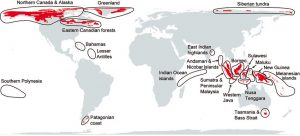This Definition Assignment was originally completed on June 2, 2021, as part of Lesson 1:3. The purpose of this assignment was to define a term of our choosing in three different forms (parenthetical, sentence and expanded). The original submission of this assignment had some errors, namely the visual was incorrectly labelled and the wrong citation format was used. These errors have since been addressed.
The objective of this assignment is to better understand the role of definitions in technical writing. I will outline three different types of definitions for the term ‘latent extinction risk’, which is often used in conservation biology.
Term: Latent Extinction Risk
Audience:
These definitions are aimed at the general public (non-scientists), especially in the context of setting public policy goals in relation to biological conservation and climate change. An accurate understanding of this term is likely to strengthen public support and awareness around the potential future risks to animal species if proper actions are not taken.
Parenthetical definition:
Conservation scientists can determine the latent extinction risk (measure of the potential for a species to become threatened) in a particular area when planning specific interventions.
Sentence definition:
Latent extinction risk is a concept in conservation biology which accounts for the fact that while certain species may not currently be endangered and at risk of extinction, due to changes in factors such as climate in the future, the species may at some time become endangered.
Expanded definition
How did this term originate?
The term ‘latent extinction risk’ was first coined by the scientists Marcel Cardillo, Georgina Mace, John Gittleman, and Andy Purvis in a paper published in 2006 in the academic journal PNAS. The term latent extinction risk is an extension of the pre-existing term ‘extinction risk’.
How is this term used or applied?
The term ‘latent extinction risk’ is a relatively niche term which has only come into existence recently. This term is almost exclusively used only in scientific papers or technical publications, but due to its importance as a concept it is sometimes used in news articles as well. When the term is used in news articles, it is often accompanied by an explanation.
One of the hotspots of latent extinction risk is Northern Canada and Alaska. Here, species such as the caribou and musk ox may be at risk in the future. A combination of factors, such as the animals’ range size, body mass and life cycle patterns, predispose species in these areas to a high risk of extinction.
Analysis
“Latent extinction risk” is a scientific term which combines three different words. At the root of this term is the word extinction, which refers to the state in which a species or genus is no longer found alive anywhere. Risk is the probability that a certain event will happen. Therefore, extinction risk is the probability (calculated by scientists) that a certain species or group of animals could become extinct. The word latent is used as an adjective. Something is latent when it is present in some form, but has not yet manifested completely.
Visuals

FIGURE 1 Hotspots of latent extinction risk from around the world. For example, the Arctic is dominated by large-bodied mammals with slow life histories, which makes them more vulnerable to environmental variation. Islands (such as Indonesia) are also high-risk areas due to the presence of many endemic species with small range sizes.
Source: Cardillo, Marcel et al. “Latent extinction risk and the future battlegrounds of mammal conservation.” PNAS March 2006: 103(11).
Works cited
Atkinson, William Illsey. “Is the Musk Ox the next Dodo?” The Globe and Mail, 10 June 2006, www.theglobeandmail.com/technology/science/is-the-musk-ox-the-next-dodo/article20412408.
Cardillo, M., et al. “Latent Extinction Risk and the Future Battlegrounds of Mammal Conservation.” Proceedings of the National Academy of Sciences, vol. 103, no. 11, 2006, pp. 4157–61. Crossref, doi:10.1073/pnas.0510541103.
Davidson, Ana D., et al. “Geography of Current and Future Global Mammal Extinction Risk.” PLOS ONE, edited by Jason M. Kamilar, vol. 12, no. 11, 2017, p. e0186934. Crossref, doi:10.1371/journal.pone.0186934.